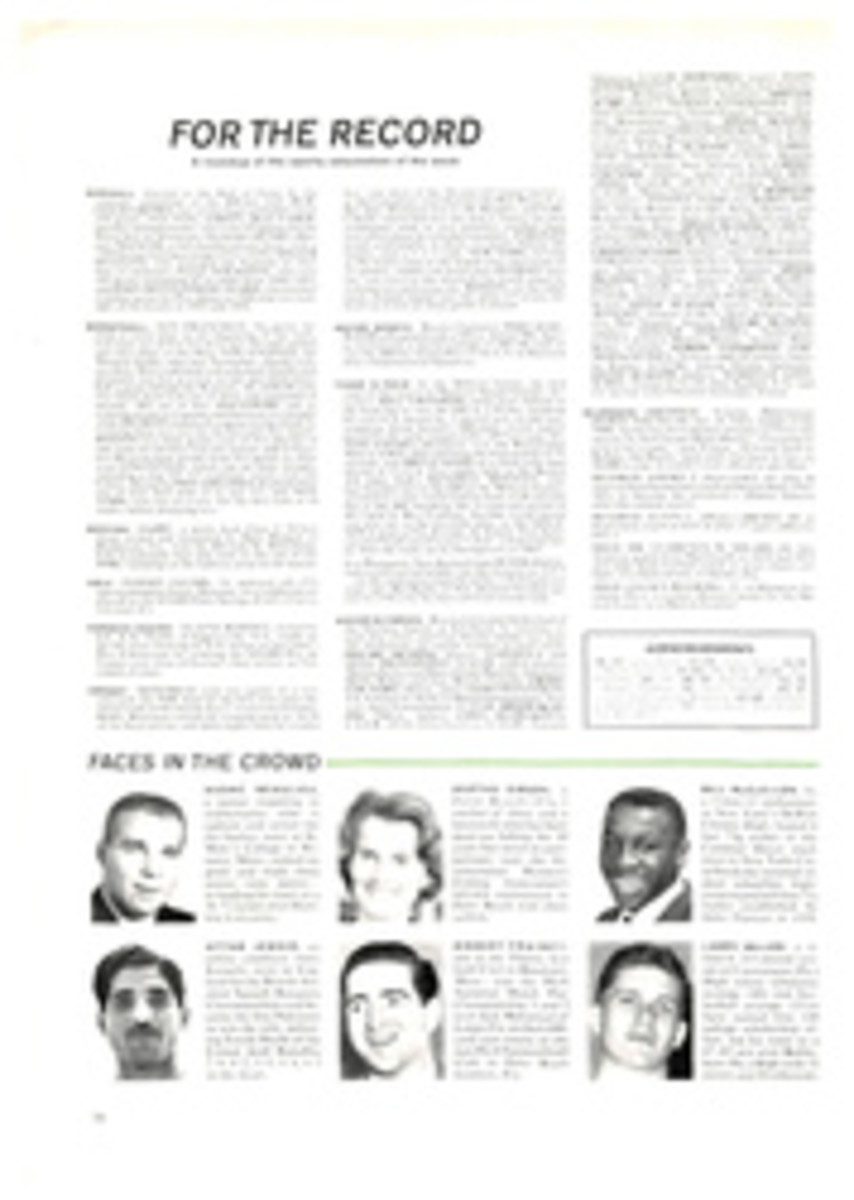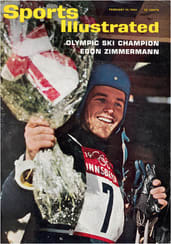
Sailing to victory with a needle and thread
Huey Long's proud veteran Ondine was first over the line at the finish of last week's 403-mile race around Florida from St. Petersburg to Fort Lauderdale, a fact which surprised no one. But when the final arithmetic was done, Ondine played a poor second fiddle to two saucy newcomers, each designed and sailed by comparative youngsters. First overall on corrected time was R. C. Dungan's 38-foot Sabre, the prototype of a new stock auxiliary (Columbia 40), which promises to add many bright feathers to the yachting cap of its designer, Charles Morgan. First in Ondine's own Class A was Ted Hood's equally new 47-foot yawl Robin, the latest of a long line of that name to be designed and sailed by one of the few (Charlie Morgan is another) quadruple-threat men in international yacht racing.
"Sailmaking is my business. Yacht designing is my hobby," says 36-year-old Hood in a summary that leaves no classifications for boatbuilding and sailing, at which he is equally skilled. Sails by Ted Hood dressed, in part or completely, every contender—including the Australian—in the America's Cup campaign of two years ago, and a Ted Hood boat—Nefertiti—was the surprise threat in the selection trials.
A quiet, unpretentious New Engender from Marblehead, Mass., whose family has lived near, by and for the sea for generations, Hood is unvaryingly phlegmatic in a sport distinguished by manic and depressive attitudes. At the start of last week's race, his crewmen somehow lost track of one of the vital warning guns, and Robin's skipper found himself far behind as the other boats slid over the line. Most skippers would have turned their crews to salt with invective. Hood slouched silently at the wheel, his eye fixed on the big genoa jib, urging Robin up, inch by inch, on the boats she should have been leading. "If I'd been Ted," said one of Robin's admiring crewmen, "I'd have killed somebody."
A little while later Robin—safely past all but her biggest rivals—was moving toward the small sub-surface hills of sand and barge-dumped debris that dot Tampa Bay and are known as "spoilage areas." To put more pressure on the boats ahead. Hood decided to sail Robin across rather than around the almost-invisible mounds. The crew, still shaken over the fouled-up start, were shaken anew at this seeming foolhardiness. As anxious eyes watched the bottom rise and fall under Robin's keel on the dial of the electronic depth-finder, Skipper Hood issued an order that sounded almost like an afterthought. "Somebody stand by the centerboard," he murmured, "and get it up quick if we touch." But Robin's centerboard stayed clear of the bottom, and Hood, still intently watching the sails, threaded her smoothly out toward the Sunshine Skyway that bridges the mouth of Tampa Bay.
Ted Hood belongs to the water, and at times his large nose, inquisitive eyes and benign, placid expression give him rather the look of a porpoise in khaki pants and an out-at-elbows sweater. Like most top racing sailors he got his first boat—a dinghy—when he was young. But, unlike most of them, he designed and built it himself and even made the sails. "She was an 11-footer and had double spreaders just like a big boat," he recalls wistfully. Young Hood cut and recut the sails of that little boat until he had just the fit he wanted and, with only a few interruptions, he has been doing the same thing ever since.
After dropping out of high school to serve a hitch in the Navy, Hood went back to graduate and face the realities of the future. Should he spend his life aimlessly messing around with boats and sails and getting nowhere? Or should he do something practical? Hood chose the practical course and spent a year studying business administration at a small New England college. Next he switched to Wentworth Institute for two more years to learn the building and housing business. But by the time he graduated he knew that houses were not for him—sails were.
Ted had spent all his vacation summers cutting sails and sewing them on a dilapidated machine, slowly but surely building himself a reputation as something of a genius among the Marblehead skippers whose sails he recut. When he finished Wentworth, he decided to expand his summer business into a full-time operation. He rented an old unheated loft belonging to a migratory sailmaker, laid newspapers on the floor so the sails would not get dirty and went on cutting and sewing. In that first year Ted Hood's gamble paid enough dividends to last him through the winter. A heated loft was available, so he rented it and carried on.
Business soon began to balloon as high as one of Hood's own beautifully shaped spinnakers and the Hood label became the hallmark of sailmaking quality. Hood sails blossomed on the best ocean racers, on champion 5.5s, on 210s and in every class that boasted sailwise skippers. Hood's success at making sails for bigger boats soon drove him out of his little loft.
"One reason I moved," he says, "was because every time I had to lay out a big sail I had to go out and rent the town hall. Finally people began to complain that I was using it too much. So I had to find a bigger loft of my own." Now he employs 64 people in a modern two-year-old loft, a boat yard and a weaving plant. Unlike many modern sailmakers, some of whom make their designs by computer, Ted Hood still believes that sailcutting is more art than science. He weaves his own Dacron sailcloth, a material even his competitors agree is the best there is. Most Dacron, when it rolls off the looms, is coated with an additive that supposedly stabilizes the slippery threads. Hood uses heat to set his fabric, and whereas other cloths tend to bag with use, Hood's sails seem to improve with age.
Hood's eye for a well-cut sail is matched by his eye for a well-turned hull. The first ocean racer built from Hood plans appeared in 1957 and immediately established herself as a threat. Hood began to get orders for boats as well as sails. But it was the 12-meter Nefertiti that spread Hood's name around the world. She was like no other 12 in history. Instead of minimum beam, which most designers favored, she was as wide as a barn door and in heavy winds went upwind as staunch and stiff as a church. When the wind died, however, so did Nefertiti—and the chance to defend in '62. Hood now thinks he knows how to correct her shortcomings. Meanwhile, his head is full of ideas for a brand-new 12.
Although Hood has designed many offshore racers and sailed them as well, his heart is really in round-the-buoys racing—the short events that can be completed in a single afternoon. "In ocean racing, the element of luck is too great," he says. "In the long-distance races you put all your eggs in one basket. Take the transatlantic race, for instance. You spend three weeks at it, then if something goes wrong the whole three weeks are shot. In round-the-buoys racing you spread the risks over a whole series. If you break down in one race, you make it up in another. Besides," he adds, looking at the matter from the point of view of a technician, "I think you learn more about boat speeds in round-the-buoys racing."
As Hood's newest Robin flew south in last week's race, there were no buoys in sight and no reliable index to her speed relative to the other boats other than the instinct of her skipper. But that instinct, as always, was sound. Given radar and other searching devices, the mark at Rebecca Shoals would not be hard to find, but radar is illegal in ocean racing and, like all the other boats, Robin had to rely on her navigator (ocean-racing veteran Junius Beebe who doubled as cook and watch captain) to find the way.
As the distance shrank, everyone searched the sea for the elusive but vital mark. There were boats two miles on one side of Robin, boats two miles on the other, and with Robin in the middle the speculation was that either one of the groups might have already spotted the mark and were sailing for it. For the first time in the race, Hood looked anxious. If Robin were wide of Rebecca Shoals, it would mean precious minutes lost and, with them, the race. But the navigation was all but perfect. Robin was right, the other boats wrong. The spinnaker thrashed down, the genoa up, as Robin turned the spidery steel marker and headed northward into the wind, bucking and pounding in the short, steep seas.
In the evening Robin passed a white-hulled sloop whose crew was huddled on her weather rail, using their combined weight to help reduce her angle of heel and thereby give her more power. Every wave that the boat sliced into threw arcs of spray over the crew, and one of Robin's hands, peering through the murk, observed smugly, "Look at those guys over there on her rail."
Hood laughed too, but pointedly. "Well," he said, "what are you waiting for?" And soon two of Robin'? crew were camped on her rail, as bedraggled as their rivals.
Early on Monday morning the wind switched. The big boats in the vanguard, Robin included, now were overtaken by little boats which, because they were smaller and slower, had rounded the mark just in time to take advantage of the wind shift. They were simply blown up on the bigger, less fortunate, leaders.
Hood, although he guessed what might be happening, strolled about his boat, fussing with the centerboard (Robin has a trick centerboard that not only goes up and down but, by mighty pushing and pulling on a winch handle, moves backward and forward, too), trimming the mainsail and winching in impossible inches on the genoa sheet all by himself.
On Monday afternoon in the middle of the strong, flowing, tepid Gulf Stream, the favorable wind that had been filling the spinnaker since morning faded. A fear began to grow aboard Robin that the wind would die altogether before she could reach the finish line ahead of the little boats. But the breeze kept whispering and, as the lights of Miami Beach came on. the end, at least for Robin, was a short 20 miles away.
A mile from the finish Jamel was a hundred yards ahead of Robin and silhouetted by the lights of Fort Lauderdale. She posed little threat since her handicap would place her far back in the race, but watching her made it obvious that a jibe was necessary if Robin was to fetch the line quickly. Jibing a big boat is a tricky job in daylight. At night it is a truly hairy maneuver, and for the first time voices were raised in earnest on Robin. "Let the sheet come forward," yelled a voice in the night. Then another voice joined in, then another. Another voice howled that the sheet had been let go. In a case like this usually the loudest complaints come from the skipper. Not aboard Robin. From Ted Hood came nothing but stoic silence, and the mess was cleared up all the quicker.
The finish line safely crossed, Robin powered slowly into the neon-lit canals of Fort Lauderdale. There, for the first time, her crew and her skipper learned that they stood where Ted Hood often stands in racing circles—at the head of his class.
PHOTO
DESIGNER HOOD'S NEW YAWL "ROBIN" HEADS STIFFLY UPWIND OFF ST. PETERSBURG
PHOTO
SKIPPER HOOD KEEPS A HAND ON THE WHEEL AND AN EYE ON THE SAILS HE MADE

